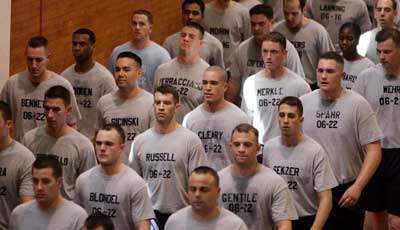- Eligible veterans include veterans who served:
During a war; or During the period April 28, 1952 through July 1, 1955; or For more than 180 consecutive days, other than for training, any part of which occurred after January 31, 1955, and before October 15, 1976; or During the Gulf War from August 2, 1990, through January 2, 1992; or For more than 180 consecutive days, other than for training, any part of which occurred during the period beginning September 11, 2001, and ending on the date prescribed by Presidential proclamation or by law as the last day of Operation Iraqi Freedom; or In a campaign or expedition for which a campaign medal has been authorized. Any Armed Forces Expeditionary medal or campaign badge, including El Salvador, Lebanon, Grenada, Panama, Southwest Asia, Somalia, and Haiti, qualifies for preference.
A campaign medal holder or Gulf War veteran who originally enlisted after September 7, 1980, (or began active duty on or after October 14, 1982, and has not previously completed 24 months of continuous active duty) must have served continuously for 24 months or the full period called or ordered to active duty. The 24-month service requirement does not apply to 10-point preference eligibles separated for disability incurred or aggravated in the line of duty, or to veterans separated for hardship or other reasons under 10 U.S.C. 1171 or 1173. The OPM page lists an FAQ section for Gulf War vets.
10-Point Preference Qualifications – Eligible veterans include veterans who served:
A veteran who served at any time and (1) has a present service-connected disability or (2) is receiving compensation, disability retirement benefits, or pension from the military or the Department of Veterans Affairs; or (3) a veteran who received a Purple Heart. An unmarried spouse of certain deceased veterans, a spouse of a veteran unable to work because of a service-connected disability, and A mother of a veteran who died in service or who is permanently and totally disabled.
A note about qualifications for mothers or unmarried spouses: These are an abbreviated version of the requirements. See the OPM guide for more information.
Research and Preparation for the testing and hiring process:
(Prior to starting your in-depth research, review the Law Enforcement Agency’and State Certifying Agency qualifying and disqualifying standards. Often, Agencies may have more stringent hiring requirements than that of the Certifying Agency. Each State on this website has a link to the Certifying body website)
- Conduct research into the best place to work and live. Issues to think about
- Big city vs small city or town?
- Employment opportunities for spouse
- School and classroom size for children
- Size of Agency
- Different career options with the Agency
- Detectives Bureau
- SWAT
- EOD
- Other specialty units
- Possibility of promotion advancement within the Agency
- Research multiple agency’s and request a ride along with them.
- Ask pertinent questions of the Officer you ride with.
Preparing for the written test process.
Find Online Study Guides and practice tests. Written tests may vary greatly. By conducting research online and taking online practice tests should prepare you sufficiently.
Physical Fitness Test:
Physical Fitness tests will vary as well. When researching the agencies that your interested in, the agency should have the physical standards posted. You may also review the Peace Officer Physical Aptitude Test which many Agencies have adopted.
Oral Board Preparation:
Many agency still have an oral board staffed typically by two Officers and one Supervisor. The following will assist you with this process.
Prior to going into an Oral board, make sure you have studied everything about the agency your testing with and all of an Officers job responsibilities. This information may be found on the Agency website and through questions posed to your ride along Officer. Oral Board:
- Wear a suit or suit pant
- Don’t be afraid to shake the board members hands.
- Take a deep breath and concentrate on the questions being asked
- Keep eye contact when responding with your answer.
- If given the opportunity, don’t be afraid to review or even change your answers.
- When the Board has been completed, thank the board members.
In lieu of an oral board, some agencies may have you participate in video based scenarios. With this process, they will place you in front of a large video screen and rate you on your reaction to the events taking place on the video. Do not be afraid to get loud and aggressive.
Background Investigation:
All agencies conduct in-depth background investigations. If you have any questions or concerns related to any incidences or activities in your life history, tell the recruiting officer or background investigator immediately. Being upfront and honest will always prove beneficial to your process rather than trying to hide a potential disqualifying incident or being untruthful.
If at anytime during the background investigation, you realize information may have been left out, notify the background investigator immediately and explain the circumstances surrounding the information.
If after studying the agency and the state certifying agency’s qualifications and disqualifying standards, you realize that you have something in your background that will disqualify you from the process, then don’t waste your time or the Agencies time and efforts. The incident will be found and you will be dropped from the hiring process.

